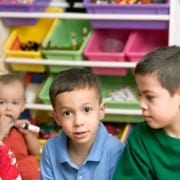Key Types of Symptoms in Autism Spectrum Disorders
Children with autism spectrum disorder (ASD) do not follow typical patterns when developing social and communication skills. Parents are usually the first to notice unusual behaviors in their child. Often, certain behaviors become more noticeable when comparing children of the same age.
In some cases, babies with ASD may seem different very early in their development. Even before their first birthday, some babies become overly focused on certain objects, rarely make eye contact, and fail to engage in typical back-and-forth play and babbling with their parents. Other children may develop normally until the second or even third year of life, but then start to lose interest in others and become silent, withdrawn, or indifferent to social signals. Loss or reversal of normal development is called regression and occurs in some children with ASD.
Three key types of symptoms:
1 Social impairment Most children with ASD have trouble engaging in everyday social interactions. According to the Diagnostic and Statistical Manual of Mental Disorders, Fourth Edition – Text Revision, some children with ASD may:
- Make little eye contact
- Tend to look and listen less to people in their environment or fail to respond to other people
- Do not readily seek to share their enjoyment of toys or activities by pointing or showing things to others
- Respond unusually when others show anger, distress, or affection.
2 Communication difficulties According to the American Academy of Pediatrics’ developmental milestones, by the first birthday, typical toddlers can say one or two words, turn when they hear their name, and point when they want a toy. When offered something they do not want, toddlers make it clear with words, gestures, or facial expressions that the answer is “no.”
For children with ASD, reaching such milestones may not be so straightforward. For example, some children with autism may:
- Fail or be slow to respond to their name or other verbal attempts to gain their attention
- Fail or be slow to develop gestures, such as pointing and showing things to others
- Coo and babble in the first year of life, but then stop doing so
- Develop language at a delayed pace
- Learn to communicate using pictures or their own sign language
- Speak only in single words or repeat certain phrases over and over, seeming unable to combine words into meaningful sentences
- Repeat words or phrases that they hear, a condition called echolalia
- Use words that seem odd, out of place, or have a special meaning known only to those familiar with the child’s way of communicating.
3 Behavioral issues Children with ASD often have repetitive motions or unusual behaviors. These behaviors may be extreme and very noticeable, or they can be mild and discreet. For example, some children may repeatedly flap their arms or walk in specific patterns, while others may subtly move their fingers by their eyes in what looks to be a gesture. These repetitive actions are sometimes called “stereotypy” or “stereotyped behaviors.”
Children with ASD also tend to have overly focused interests. Children with ASD may become fascinated with moving objects or parts of objects, like the wheels on a moving car. They might spend a long time lining up toys in a certain way, rather than playing with them. They may also become very upset if someone accidentally moves one of the toys. Repetitive behavior can also take the form of a persistent, intense preoccupation. For example, they might be obsessed with learning all about vacuum cleaners, train schedules, or lighthouses. Children with ASD often have great interest in numbers, symbols, or science topics.
While children with ASD often do best with routine in their daily activities and surroundings, inflexibility may often be extreme and cause serious difficulties. They may insist on eating the same exact meals every day or taking the same exact route to school. A slight change in a specific routine can be extremely upsetting. Some children may even have emotional outbursts, especially when feeling angry or frustrated or when placed in a new or stimulating environment.
No two children express exactly the same types and severity of symptoms. In fact, many typically developing children occasionally display some of the behaviors common to children with ASD. However, if you notice your child has several ASD-related symptoms, have your child screened and evaluated by a health professional experienced with ASD.
Related Disorders
Rett syndrome and childhood disintegrative disorder (CDD) are two very rare forms of ASD that include a regression in development. Only 1 of every 10,000 to 22,000 girls has Rett syndrome. Even rarer, only 1 or 2 out of 100,000 children with ASD have CDD.
Unlike other forms of ASD, Rett syndrome mostly affects girls. In general, children with Rett syndrome develop normally for 6–18 months before regression and autism-like symptoms begin to appear. Children with Rett syndrome may also have difficulties with coordination, movement, and speech. Physical, occupational, and speech therapy can help, but no specific treatment for Rett syndrome is available yet.
CDD affects very few children, which makes it hard for researchers to learn about the disease. Symptoms of CDD may appear by age 2, but the average age of onset is between age 3 and 4. Until this time, children with CDD usually have age-appropriate communication and social skills. The long period of normal development before regression helps to set CDD apart from Rett syndrome. CDD may affect boys more often than girls.
Children with CDD experience severe, wide-ranging and obvious loss of previously-obtained motor, language, and social skills. The loss of such skills as vocabulary is more dramatic in CDD than in classic autism. Other symptoms of CDD include loss of bowel and bladder control.
Adapted with permission from The National Institute of Mental Health









